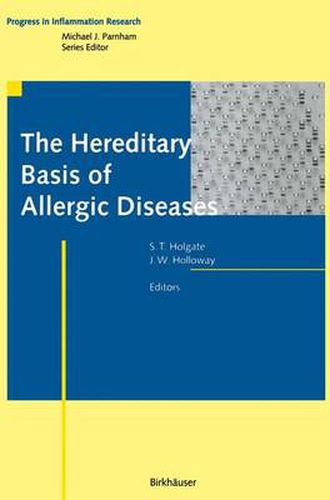Readings Newsletter
Become a Readings Member to make your shopping experience even easier.
Sign in or sign up for free!
You’re not far away from qualifying for FREE standard shipping within Australia
You’ve qualified for FREE standard shipping within Australia
The cart is loading…






This title is printed to order. This book may have been self-published. If so, we cannot guarantee the quality of the content. In the main most books will have gone through the editing process however some may not. We therefore suggest that you be aware of this before ordering this book. If in doubt check either the author or publisher’s details as we are unable to accept any returns unless they are faulty. Please contact us if you have any questions.
Allergic diseases are complex and involve a range of environmental factors interacting with a susceptible genotype. The familial clustering of diseases, such as asthma and hay fever, has been recognized for over two centuries, but the basis for this had to await the molecular biological revolution. Estimates of the contribution that genetic factors make to asthma susceptibility range from 35% to 70%. For the majority of allergic diseases, segregation analysis has not identified a consistent Mendelian pattern of inheritance, which, when combined with multiple phenotypes and environmental interactions, has made identifying candidate genes especially difficult and, at times, controversial. Part of the difficulty has been lack of agreement over phenotype definitions, reduced power of studies to predict linkage and association and, importantly, lack of true heterogeneity between populations. Despite these difficulties, the last decade has witnessed enormous progress in this field. The Hereditary Basis of Allergic Diseases brings together scholarly reviews of the emergent and promising genetic factors influencing susceptibility to and progression of allergic diseases such as asthma. It is aimed at those clinicians and scientists with an interest in allergic diseases. It aims through reviews of a number of different studies in the field to not only provide a review of current knowledge but also examples of the processes by which the genetic factors that contribute to allergic diseases are being elucidated by workers in the field.
$9.00 standard shipping within Australia
FREE standard shipping within Australia for orders over $100.00
Express & International shipping calculated at checkout
This title is printed to order. This book may have been self-published. If so, we cannot guarantee the quality of the content. In the main most books will have gone through the editing process however some may not. We therefore suggest that you be aware of this before ordering this book. If in doubt check either the author or publisher’s details as we are unable to accept any returns unless they are faulty. Please contact us if you have any questions.
Allergic diseases are complex and involve a range of environmental factors interacting with a susceptible genotype. The familial clustering of diseases, such as asthma and hay fever, has been recognized for over two centuries, but the basis for this had to await the molecular biological revolution. Estimates of the contribution that genetic factors make to asthma susceptibility range from 35% to 70%. For the majority of allergic diseases, segregation analysis has not identified a consistent Mendelian pattern of inheritance, which, when combined with multiple phenotypes and environmental interactions, has made identifying candidate genes especially difficult and, at times, controversial. Part of the difficulty has been lack of agreement over phenotype definitions, reduced power of studies to predict linkage and association and, importantly, lack of true heterogeneity between populations. Despite these difficulties, the last decade has witnessed enormous progress in this field. The Hereditary Basis of Allergic Diseases brings together scholarly reviews of the emergent and promising genetic factors influencing susceptibility to and progression of allergic diseases such as asthma. It is aimed at those clinicians and scientists with an interest in allergic diseases. It aims through reviews of a number of different studies in the field to not only provide a review of current knowledge but also examples of the processes by which the genetic factors that contribute to allergic diseases are being elucidated by workers in the field.